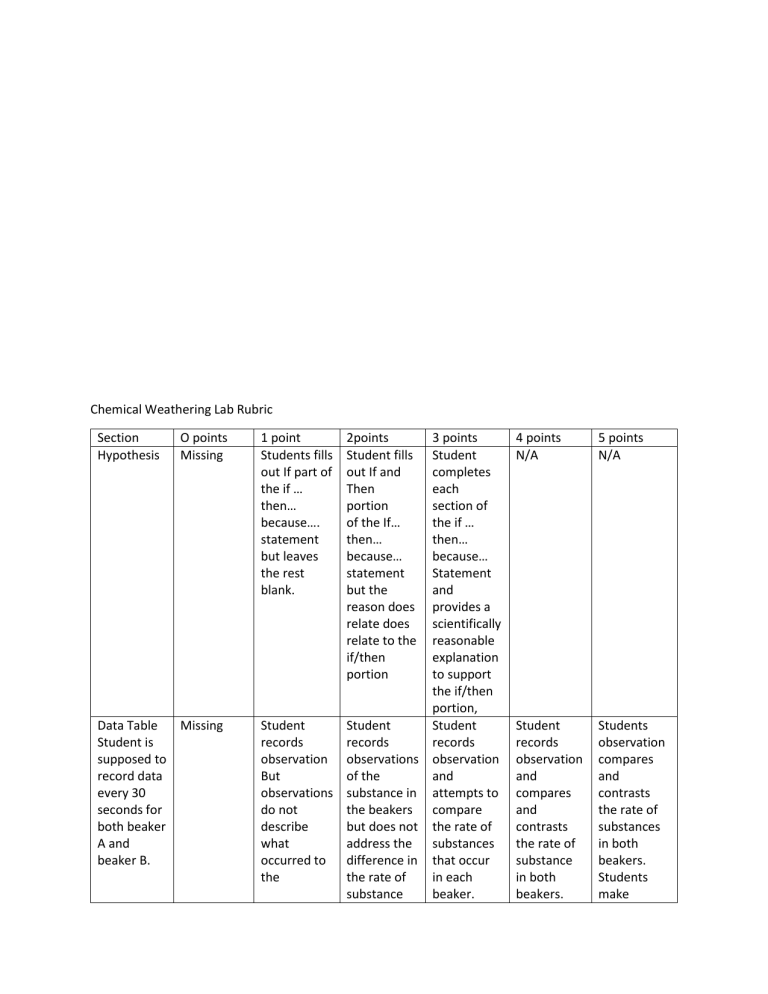
Chemical Weathering Lab Rubric Section Hypothesis O points Missing Data Table Missing Student is supposed to record data every 30 seconds for both beaker A and beaker B. 1 point Students fills out If part of the if … then… because…. statement but leaves the rest blank. 2points Student fills out If and Then portion of the If… then… because… statement but the reason does relate does relate to the if/then portion 3 points Student completes each section of the if … then… because… Statement and provides a scientifically reasonable explanation to support the if/then portion, Student Student Student records records records observation observations observation But of the and observations substance in attempts to do not the beakers compare describe but does not the rate of what address the substances occurred to difference in that occur the the rate of in each substance beaker. 4 points N/A 5 points N/A Student records observation and compares and contrasts the rate of substance in both beakers. Students observation compares and contrasts the rate of substances in both beakers. Students make substance in the beakers. occurring in the two beakers. observations using more than one of the five senses. Observation Questions Question Number 1 2 3 4 1 point Student describes what happened to the material without analyzing the data they collected. Student describes what happened to the material in Beaker B without analyzing the data they collected. Students describes the differences in the reaction rate of the two beakers but does Describe the difference between the rate of chemical substance in both beakers. Students describes the similarities in substances of the two beakers, without referring to their observations, and data collected. 2 point Student describes what happened in beaker A based on the analysis of the data collected. Student describes what happened to the material in Beaker B based on the analysis of the data collected. Student describes what differences in both beakers and also describes the difference In the rate of reaction of chemical process. Student describes the similarities in substances of two beakers by providing evidence of the data they collected. Student states which beaker’s particles reacted more quickly with out providing a scientifically reasonable explanation. Students states which beaker’s particles reacted more quickly and provides a scientifically reasonable explanations based on their observations. Student describes the difference in reaction time between Beaker A and Beaker B without using the data collected to support Students describes the differences in reaction time in both beakers and mentions that one piece of substance was crushed while the Question Number 1 1 point Student makes a claim how substance is more susceptible to chemical weathering after the Hurricane Sandy but fails use data gatherer. Student fails to connect claim to the scientific principal (Increase the surface are increase in chemical weathering) 2 Students make claim regarding whether the reaction rate faster or slower than the pieces that remined intact. Student fails to use the data gathered to support their claim and connect it to the idea that as the surface area increases so will the rate of reaction. Student states whether or not the data collected supported their hypothesis, but fails to provide evidence based on the analysis of their data. 2 points Student makes claim regarding how Sally’s house is more susceptible to chemical weathering after Hurricane Sandy. Student supports claim with data collected, and connects it to how the rate of chemical weathering will increase if the particle size will increase. Student makes claim regarding whether the substance will shrink faster or slower than the pieces that remained intact. Student uses data collected as evidence to support claim and justifies scientific principal. 5 6 Conclusion 3 Student’s state whether or not data collected supported their hypothesis by analyzing their observations and data to support their claim. Who knows it? Who knows some of it? Who knows nothing? Who has misconceptions? Such as? Focus students 1 2 3 Implications for future instruction





